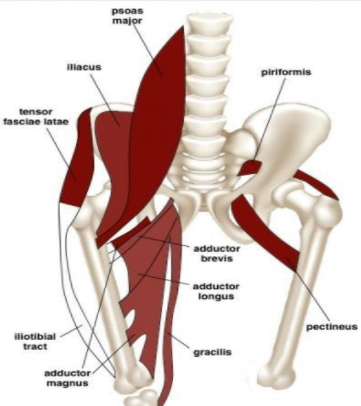Back and Hip Pain in Athletes (Part 1): How the Spine, Hip and Pelvic Floor Interacts
Active lifestyle and participation in non-competitive and competitive activities and sports have become an integral part of our everyday life. These activities may include anything from simply increasing the individual’s walking distance and yard work or active backdoor playing with family to goal driven running, sports, dancing, horse riding, biking or simply increasing fitness workouts such as indoor or studio classes. What is critical to all these activities is ‘motor control’ -how humans use their brain to activate and coordinate the muscles to perform a task or a skill. Our bodies are designed to explore all these activities. However, when the demands of the exercise exceed the ability of that body part, or performed without proper body mechanics, activity results in pain and injury.
Is my pain caused by the hip or the back?
Patients often say that their hip hurts. When asked to point exactly where it hurts, it could be the lowest part of their back or buttock or groin or even the front or back of their thighs. There is such a big overlap of the region of hip pain. Primary pain generator for this reported pain similarly could be a variety of sources including the lumbar spine, hip joint or the sacroiliac joint, and pelvis and pelvic floor muscles. In fact, one of the most common sources of pain that is often missed is the pelvic floor. Pelvic floor muscles form the ‘floor’ of the core and can be the primary pain generator in many women and men.
If one could imagine the core as a balloon, the diaphragm forms the top of the balloon and the bottom is made of pelvic floor and the sides by the abdominal muscles, back of the balloon is the spine and buttock muscles. Deeper in the buttock are the pelvic floor muscles that also attaches to the hip bones. Pain present anywhere between your ribs to the feet can be a challenging puzzle to solve as the entire region is biomechanically connected. The primary driver for back, hip or groin pain could be the pelvic floor or vice versa that can be determined only with a thorough evaluation of each of these sources.

Fig1: Core and pelvic floor muscles
My MRI is normal so why am I in pain?
Pain in these areas can be very frustrating for most individuals whose goals are to return to active lifestyle. Imaging studies such as X-ray or MRI can be normal which is helpful to rule out some of the causes such as disc herniations or acute muscle tears or joint abnormalities. However, these imaging studies cannot diagnose muscle imbalance or biomechanical abnormalities that are diagnosed by a specialist with expertise in these areas of practice.
Persistent pain without any imaging findings or response to usual care requires a closer evaluation to identify the barrier with focus on biomechanics, motor control and muscle recruitment strategies. Biomechanical muscle imbalance causing pain in these areas can arise from the lower extremities, pelvic floor, thorax, twisting of the trunk (incongruent rotations of thorax and pelvis) or pulling of the covering of the spinal cord at the coccyx from prior disc herniations etc. Therefore, it’s important to seek help for a thorough musculoskeletal examination to identify the barriers to progress and implement a change to the treatment plan.

Fig2: MRI of lumbar spine showing disc herniation at L5-S1

Fig 3: Picture showing proximity of sciatic nerve to the pelvic floor muscles
What does the pelvic floor do and how can it be related to my pain?
The pelvic floor is comprised of bony structures and muscular structures and is described as the ‘floor’ of the core. Therefore, it helps supports the pelvic organs and thereby help maintain urinary and bowel continence, aids in sexual function and responsible for trunk and pelvic girdle stability.

Fig 4: Bony and muscular anatomy of the pelvis
Pelvic floor muscles do not function in isolation. Several multi-segmental muscles of the trunk and lower limbs need to work in balance to prevent dysfunction and pain. This includes:
- Abdominal muscles such as the rectus abdominis, obliques and iliopsoas: core muscles that are important to maintain erect posture and neutral spine as well as essential functional muscles in activities where hip bending is involved such as walking and running
- Inner thigh muscles: namely the adductors that attach to the undersurface of pelvis bone are important pelvic and core stabilizers
- The iliotibial band: sides of the thigh
- The hamstrings: back of the thigh
- The quadriceps: front of the thigh
- The quadratus lumborum: in the lower back
- Gluteal muscles and deep gluteal muscles: piriformis and Obturator internus (deep pelvic floor muscles)

Fig 5: Picture showing how the spine, hip and pelvic muscles are related to each other
Because of this interaction between the hip, lumbar spine and pelvic floor, it is crucial to maintain good body biomechanics with any type of exercise to avoid muscle compensation, overactivity or underactivity of the different muscle groups that eventually causes muscle dysfunction and persistent pain.
To learn how to address your pain in these areas, please click here for part 2.




